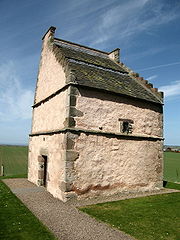
Athelstaneford
Encyclopedia

East Lothian
East Lothian is one of the 32 council areas of Scotland, and a lieutenancy Area. It borders the City of Edinburgh, Scottish Borders and Midlothian. Its administrative centre is Haddington, although its largest town is Musselburgh....
, Scotland
Scotland
Scotland is a country that is part of the United Kingdom. Occupying the northern third of the island of Great Britain, it shares a border with England to the south and is bounded by the North Sea to the east, the Atlantic Ocean to the north and west, and the North Channel and Irish Sea to the...
. It is close to the town of Haddington
Haddington, East Lothian
The Royal Burgh of Haddington is a town in East Lothian, Scotland. It is the main administrative, cultural and geographical centre for East Lothian, which was known officially as Haddingtonshire before 1921. It lies about east of Edinburgh. The name Haddington is Anglo-Saxon, dating from the 6th...
and lies approximately 20 miles east of Edinburgh
Edinburgh
Edinburgh is the capital city of Scotland, the second largest city in Scotland, and the eighth most populous in the United Kingdom. The City of Edinburgh Council governs one of Scotland's 32 local government council areas. The council area includes urban Edinburgh and a rural area...
. The village is also known locally as Elshingford.
According to popular legend, Athelstaneford is where the original Scottish saltire
Flag of Scotland
The Flag of Scotland, , also known as Saint Andrew's Cross or the Saltire, is the national flag of Scotland. As the national flag it is the Saltire, rather than the Royal Standard of Scotland, which is the correct flag for all individuals and corporate bodies to fly in order to demonstrate both...
- the white diagonal cross on a sky blue background - was first adopted. On the eve of a battle between an army of the Picts and invading Angles from Northumbria (English) in 832AD, Saint Andrew
Saint Andrew
Saint Andrew , called in the Orthodox tradition Prōtoklētos, or the First-called, is a Christian Apostle and the brother of Saint Peter. The name "Andrew" , like other Greek names, appears to have been common among the Jews from the 3rd or 2nd century BC. No Hebrew or Aramaic name is recorded for him...
, who was crucified on a diagonal cross, came to the Pictish King Óengus II in a vision promising victory. The next morning the Picts observed a white cross formed by clouds in the sky. They won the battle and attributed their victory to the blessing of Saint Andrew, adopting his form of the cross as their flag, and naming him as their patron saint
Patron saint
A patron saint is a saint who is regarded as the intercessor and advocate in heaven of a nation, place, craft, activity, class, clan, family, or person...
.
The leader of the retreating Angles, Athelstan,, was slain at a nearby river crossing, hence the name Athelstaneford. There are several versions of the story, of which this is one of the more popular. Whatever the truth, the legend has cemented Athelstaneford's place in Scotland's history.
The village is home to the National Flag Heritage Centre which occupies a lectern doocot built in 1583 and rebuilt in 1996. It is situated to the rear of the village church.
Other attractions

Athelstaneford Parish Kirk has a connection with the author Nigel Tranter
Nigel Tranter
Nigel Tranter OBE was a Scottish historian and author.-Early life:Nigel Tranter was born in Glasgow and educated at George Heriot's School in Edinburgh. He trained as an accountant and worked in Scottish National Insurance Company, founded by his uncle. In 1933 he married May Jean Campbell Grieve...
who was a prominent supporter of the Scottish Flag Trust. He married in the church, and in April 2008 a permanent exhibition of his memorabilia was mounted in the north transept
Transept
For the periodical go to The Transept.A transept is a transverse section, of any building, which lies across the main body of the building. In Christian churches, a transept is an area set crosswise to the nave in a cruciform building in Romanesque and Gothic Christian church architecture...
of the church. Items include a copy of Nigel Tranter's old typewriter, a collection of manuscripts and books, and other personal items. The display was previously at Lennoxlove House
Lennoxlove House
Lennoxlove House is a historic house set in woodlands half a mile south of Haddington in East Lothian, Scotland. The house comprises a 15th-century tower, originally known as Lethington, and has been extended several times, principally in the 17th, 19th and 20th centuries...
, and prior to that at Abbotsford House
Abbotsford House
Abbotsford is a historic house in the region of the Scottish Borders in the south of Scotland, near Melrose, on the south bank of the River Tweed. It was formerly the residence of historical novelist and poet, Walter Scott...
, the home of Sir Walter Scott.
External links
- The History of the Saltire at visitscotland.com
- The Scottish Saltire at Flags of the World
- The Scottish Flag Trust The trust has responsibility for the upkeep and operational costs of the Heritage Centre and the Saltire Memorial in Athelstaneford

